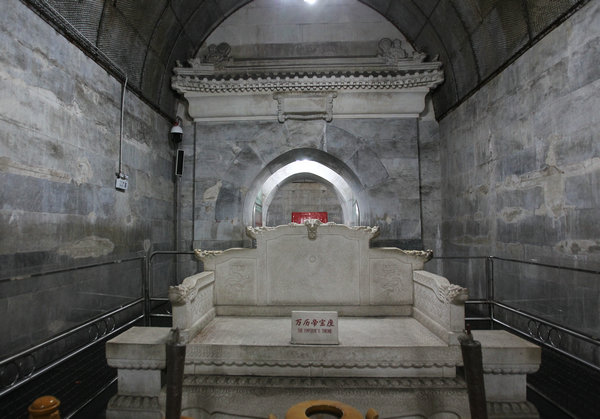
(Photo provided to China Daily)
"It's clear now that the stone tunnel constitutes the last section of the journey taken by Emperor Wanli and his empresses en route to their final resting place," Yang says. "The team could not find the stone tunnel initially because there is a turn between the brick tunnel and this stone one."
At the end of this 40-meter long tunnel lies "the wall", called jin gang qiang, or "the impregnable wall". Made of big stone blocks, the wall indeed seems impregnable until the archaeologists realized that the central part of it could be easily dismantled, by pulling out the blocks of which it is composed, one by one, like pulling drawers from a chest.
Sun remembers vividly when the first stone block was pulled out.
"There was a clear puff, accompanied by a plume of dark smoke. The air, trapped inside for more than three centuries and thick with the smell of mold, charged out.
Wearing a face mask and with a rope tied to his waist, Zhao, fresh from the Archaeology Department of Peking University, was the first to get in.
"The sleeves and both parts of his trousers were sealed tightly so no noxious air could enter," Sun says.
When Zhao arrived at the stone gate standing right behind the wall, it was closed. Under the light of an electric torch, he discerned a narrow opening in between the two stone panels. Pressing himself against that opening, he could see a huge rectangular stone slab leaning against the panels from inside the chamber. It was a lock, a firm one-anyone who wished to enter the forbidden ground needed to find a way to remove the stone-from the outside.
Zhao's answer to the challenge was some thick iron wire.
"He fashioned the wires into a half circle with a long handle and then gradually put that circle through the opening, noosed the stone slab on the top and pushed," says Yang, who has lived in a retirement home in suburban Beijing since her husband died at the age of 84 in 2010.
"The upper edge of the stone slab, the part that was in contact with the gate, was slightly lifted backward, so the gate could be pushed open just a little bit," she says.
A little bit indeed, but big enough for Sun, back then a thin 18-year-old, to squeeze through.
That was in May 1957. A year had passed from when the team members had dug out their first shovel of dirt.


















































